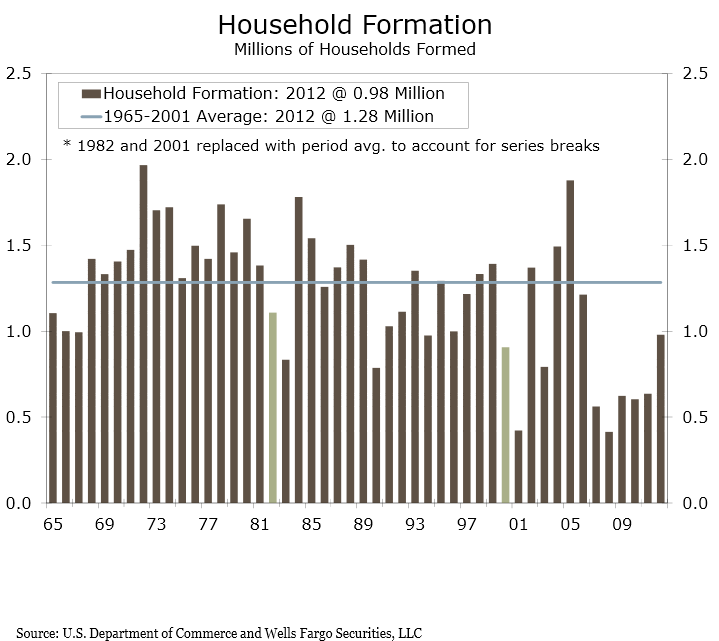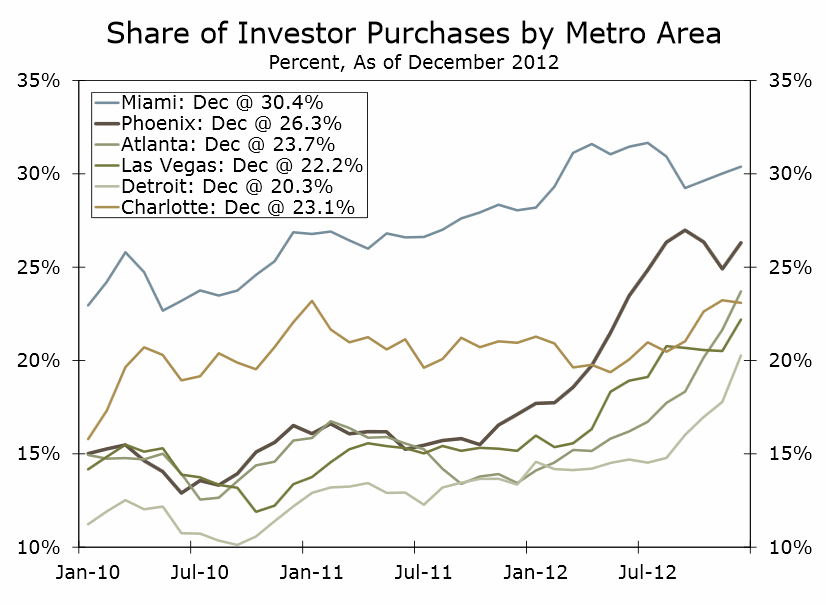Wells Fargo bank held a conference call on the outlook for the housing market on Tuesday, the first of several planned for 2013. The bank's economists Mark Vitner and Anika Kahn gave a fairly wide-ranging presentation about current economic and housing indicators which was geared primarily toward investors.
The GDP has averaged 2.1 percent growth in the quarters since the recession ended four years ago. Vitner said that he expects growth to accelerate modestly over the next two years, There was a big shift in drivers over the last year with housing picking up while the government sector proved to be a drag on growth. With growth in the state and local government sectors looking better, overall government growth will be providing less of a brake on the economy although the federal government contribution is not expected to improve.
Attention is shifting toward the Federal Reserve and their policy of quantitative easing. Vitner does not expect them to make an immediate move to wind it down but does expect action in that direction by the end of the year. In the meantime the Fed is acting to direct attention to the possibility of a move which is having some of the same effect as an actual move.
There has been talk about deflation but Vitner said he does not see that as a problem even as inflation remains low. There are some areas that are experiencing inflation such as the stock market and farm prices.
Household formation picked up at the end of 2012 but while it is up off of the floor it is far from normal. Household assets have returned to pre-recession levels but this growth in assets has accrued to the wealthy; other income groups have actually seen a decline in wealth which is one reason that household formation is not returning to normal levels. While employment is also improving, they are not quality jobs. They are lower paying, in some cases temporary positions and not type of employment that will give a boost to housing demand

Vitner said that the conventional wisdom is that refinancing has played out, but one-half of outstanding mortgages have interest rates of 5 percent or above. Purchase mortgages have not picked up appreciably despite the low interest rates and he feels that rates are nowhere near the point where they will begin to turn off purchasers since the low rates didn't turn them on. Job growth is a bigger driver of housing demand.
Purchase Index vs 30 Yr Fixed
Refinance Index vs 30 Yr Fixed
Mortgage underwriting has been tight and won't be loosening up, the economists said. Lenders are in a better position than they were a year ago but are still putting out the fires left over from the crash so few exceptions are being made to underwriting standards. Many younger buyers - which constitute a large part of first-time buyers are finding themselves unable to buy because a high percentage have low FICO scores that make it impossible to qualify for prime mortgages.
Viter and Kahn said they do not see housing starts returning to normal until 2016 although they will get incrementally better. Projections are for 665,000 single-family starts this year, up from 535,000 last year, and 820,000 starts in 2014. Multifamily starts, however are projected to level off from the spurt this year - when starts are expected to jump from 245,000 to 325,000 - and increase only by 25,000 units in 2014. Demand for apartments has been strong but should reach a balance with supply by late this year. It will be much less of a slam-dunk to build apartments after that than it was two years ago, they said.
Much of the building going on recently has been by large national and regional companies which had access to capital, were able to buy up prime lots and unfinished developments and able to sustain a workforce. The economists said they expect as the economy picks up that custom builders will slowly move back into the market. Construction prices have come down in the last quarter, especially for lumber.
The two said they expect home price increases to level off next year, going from a 7.2 percent increase in 2012 and 8.8 percent this year to 1.9 percent in 2013. Much of the price increases to date have been fueled my people picking up houses at the lower end that had been severely devalued and by steadier sales at the upper end. Investors have made a significant contribution to sales, especially at the lower end, and may start to pull back from the market. First-time homebuyers are still having problems entering the market, and the move-up market is struggling, partly because so many current homeowners are unable to sell their homes because of negative or near negative equity.
The higher than normal premium on new house prices may be a function both of the fact the upper end has held up better than the rest of the market and also low interest rates. With rates at 3.5 percent it is easy to opt for the fancier kitchen that is going to be paid for over 30 years.

Vitner and Kahn said they are troubled by the move on the part of institutional investors to buy up large numbers of homes to convert to rentals. This is leading to a run up in home prices in some major markets and is creating a new asset class, which by its nature is speculative and usually leads to problems. It is of particular concern that this is going on in many geographic areas that are not traditionally favorable to rentals because of a surplus of low-cost housing and the ease of building. As these investors find it harder to raise rents they will also find it harder to raise capital. While Vitner said they don't expect this asset class to implode, if it should suffer a sharp setback, it at least should not come back to harm the banks as the last crash did.








